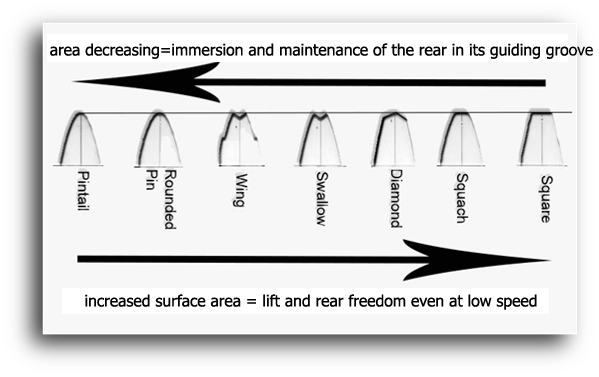Influence of the surfboard tail shapes
Overall, long surfboards respond better with rounded tails (rear), because they promote ease of passage from rail to rail (roll) by reducing the volumes far from the board core (roll axis), which are difficult to immerse without moving the foot close to the rail.
Short boards, intended for maneuvers with back support, will seek to keep an active lift zone behind. They will therefore use tail shapes producing wider surfaces to limit the sinking of the board in the braked turns generating slow phases. Here are some basic surfboard tail shapes derived from these principles:

Diagram of the influence of the rear airfoil..
 |
• Square tail: A large surface provides great lift. This type of rear sinks little. This results in freedom of movement, even in low-speed phases. This rear sliding freedom can be used to exploit the drive (see definition above) of the fins to generate acceleration during manoeuvres. The width generates a more difficult transition from rail to rail, due to the high anti-roll stability (anti-roll) • Squash tail : A little narrower than the Square, so the roll stability is reduced to facilitate the transition from rail to rail. You lose lift and freedom at low speed, you have to start to moderate the rear support braking the board in radical turns, otherwise you will lose the sequence and the commitment necessary to anticipate the wave. A guiding furrow begins to dig in keeping the board a little more in line. • Diamond tail : A mixture of the properties of the square and the pintail: The rail is shorter than with the Swallow, it will be possible to switch more easily from rail to rail by limiting the volume of submerged rail. We engrave the guiding furrow which slightly maintains the back despite its width. • Swallow tail : Wide rear, a long rail so more effort to immerse it and to pass from rail to rail. A pintail on each side therefore a stabilizing guide groove during rail support. • Wing tail : a Swallow with a little less length of rail, we want to take advantage of a wide rear but we increase the sinkage of the rail by reducing its volume by reducing its length which stops before the rear of the board. • Rounded pin / Round tail : Wider therefore more carrying than the pintail, less steering and more suitable for maneuvers on the back and slower waves than those reserved for the Gun. We find this type of tail on mini Malibu and Egg type boards and shortboards. The more you round, the closer you get to the free and carrying character of the Square tail, while keeping a smooth transition from rail to rail. • Pintail : The low bearing surface of this type of rear ending in a point creates a guiding groove which guides and stabilizes the rear. This narrow shape also allows a quick and incisive passage from rail to rail thanks to its low resistance to roll (Roll). Big wave boards like guns benefit from this guiding stability while taking advantage of the cut trajectories offered by the curve of the rocker printed by the ease of immersion. |